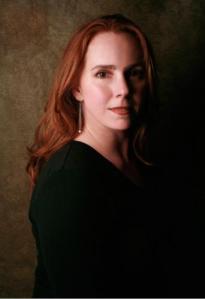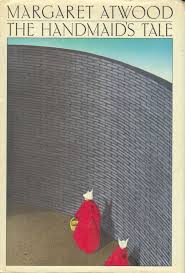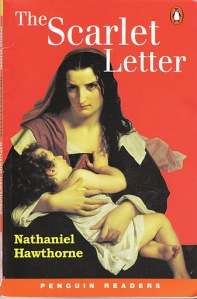
A 26-year-old woman named Hannah awakens on an operating table and finds herself red — not just red, but Red, her skin entirely “the color of newly shed blood,” from her scalp to her toes. She holds her hands above her face, finding them “starkly alien as starfish.” This is a shock but not a surprise — she knows why she is in this mirrored cell, why she has been “chromed” : she terminated a pregnancy and refused to name either the doctor who did it or the father. In dystopian future Texas this is a felony, and her punishment is that her skin has been medically dyed red for the next 16 years.
A bold and gripping re-imagination of Nathaniel Hawthorne’s “The Scarlet Letter,” with shades of Margaret Atwood’s “The Handmaid’s Tale,” Hillary Jordan’s “When She Woke” follows Hannah as she decides the next steps in a life that seems suddenly like it will crush her. After a month she’ll be released from this high-tech prison and sent back into the real world, where other criminals like her must try to survive in regular society, their skin dyed to denote their crime. The outside world is not kind to Reds like Hannah, and many are kidnapped, sold into slavery or prostitution, or murdered by vigilantes in a group called The Fist, to which her brother-in-law belongs. She’s torn by a love for her family, especially her sister Becca, and she still loves the man with whom she had the affair, a surprisingly sympathetic (and, problematically, married) young high-profile church leader, who’s likeiwse tormented by his role in her punishment and still desperately in love with her.

author Hillary Jordan
I stepped gingerly into “When She Woke,” concerned that it would feel too much like an intricately tailored liberal nightmare, or, worse yet, like propaganda. To my pleasant surprise it was neither. Hannah is a fully realized character, not a prop. Her childhood within a close-knit, devoutly Christian family is sympathetically rendered. Her parents’ brand of Christianity is not the vengeful sort we sometimes see flaring out of modern Texas (with its highest-capital-punishment-rate in the U.S.) but a thoughtful, nearly intellectual kind seemingly informed by Albert Schweitzer; they abhor the death penalty and abortion equally and minister to the needy with true hearts. But the taking of a human life (and this, in their worldview, includes abortion) is a terrible sin, and Hannah must live with the knowledge that what she’s done has devastated her family. Hillary Jordan writes Hannah’s interior life and search for a communion with God in such a way that you believe it, and when, overcome with relief at one point in the novel, she falls to her knees and prays, even an atheist could understand what she gets out of prayer:
Oh, thank God, she said, and then acted on it, falling to her knees on the floor, bowing her head and praying, the same five simple words, over and over: Thank You for his life. At some point, she became aware of movement around her, followed by a charged stillness. She looked up and saw that everyone [was kneeling], their heads bent in silent prayer. She experienced a moment of incandescent wonder, a sense of being connected, not just to these people, but to everyone and everything alive.
———————-
The pacing in “When She Woke” is impeccable. Somehow, Jordan unspools character information almost seamlessly, so that you become attached to her characters exactly as your fear for them intensifies: it’s a perfect storm of good writing.
From an English major’s perspective, the nods to “The Scarlet Letter” and “The Handmaid’s Tale” are enjoyable and never glaring; they’re just there, giving extra backbone to the work. When Hannah befriends another young Red named Kayla, you hear Atwood’s “Now we walk along the same street, in red pairs.”

The fetishization of pregnancy is here from Atwood, too; in “When She Woke” an epidemic STD has swept much of the US and rendered many women infertile, so that those who are pregnant, and their precious unborn, are placed on a moral and political pedestal:
One of them is vastly pregnant…There is a shifting in the room, a murmur, an escape of breath; despite ourselves we turn our heads, blatantly, to see better; our fingers itch to touch her. She’s a magic presence to us, an object of envy and desire; we covet her. She’s a flag on a hilltop, showing us what can still be done: we too can be saved. (Handmaid’s Tale)
In 1985, when Atwood wrote “The Handmaid’s Tale,” childless women weren’t constantly bombarded with social media squealing about their friends’ impending or newborn babies; tabloid magazines didn’t breathlessly declare each celebrity pregnancy as if getting knocked up were somehow the great social equalizer between the Snookis of the world and the Princess Kates. There’s a little prescience in Atwood’s writing here; she, an Old Guard feminist, could hardly have imagined the extent to which babies would become womens’ 21st century form of currency.
As to the shades of “The Scarlet Letter” in “When She Woke,” they are even more numerous. When Hannah is forced, at a truly creepy rehabilitation center, to sew a doll of the baby she’ll never give birth to, she names the baby Pearl, Hester’s daughter in “The Scarlet Letter.”

Many people are not aware that Elijah Wood modeled for this cover of The Scarlet Letter
Hawthorne is also there in Hannah’s love of dressmaking; sewing was a particular skill of Hester Prynne’s. But of course, Hannah’s primary link to Hester is the burden of punishment they must bear:
Giving up her individuality, she would become the general symbol at which the preacher and moralist might point, and at which they might vivify and embody their images of woman’s frailty and sinful passion. Thus the young and pure would be taught to look at her, with the scarlet letter flaming on her breast — at her, the child of honorable parents –…at her, who had once been innocent — as the figure, the body, the reality of sin. (Scarlet Letter)
Woman’s body as the figure, the reality of sin — it’s a notion both strange and common to us here in 2014 America. Are we all that far from Hawthorne’s 1850s Boston or Jordan’s hellish future Texas? Women are still, 164 years after Hester Prynne, both a cause and a symptom of man’s darkness. From Adam and Eve to The House of Mirth, from Rescue Me to True Detective and everything in between, to the new war literature I’ve been reading in which men return from combat, damaged, only to act out before their stunned girlfriends and wives — what art would we have without women as the recipients of and penintents for man’s self-loathing?
The redemption in “When She Woke” is Jordan’s careful individualization of Hannah Payne. Hannah makes several surprising decisions throughout the novel; she is acted upon, over and over again, but the biggest decisions of the story belong to her alone. You must set foot upon the path with nothing but yourself, she thinks. And you can hear Hawthorne again: Many people refused to interpret the scarlet A by its original signification. They said that it meant Able; so strong was Hester Prynne, with a woman’s strength.
—————————————————
Buy “When She Woke” and Jordan’s first novel, “Mudbound” , winner of the 2006 Bellwether Prize adjudicated by Barbara Kingsolver.
“Aftermirth” — a new Kindle Single by Hillary Jordan — sounds delightfully morbid and unusual, too.

This book sounds so cool! The current dystopian trend meets old timey morality. I love it! It makes me think of a grown up version of the YA book “Bumped” by Megan McCafferty. (The book is strange but so, so smart. I think McCafferty is a genius.) I’m adding this one to my list!
LikeLike
I haven’t read “Bumped.” “Strange and smart” sounds good to me. Thanks for the tip!!
LikeLike
Good review-thanks. 2 minor comments -cover for The Scarlet Letter is from a painting by Hughes Merle which was done in 1859 long before Elijah Wood. Also The Scarlet Letter was published in 1850 but Hawthorne set the story of Hester Prynne in Puritan New England in Boston much earlier in 1652 which would be some 360 years before our time and would make Hester’s relevance to our modern day even more astounding.
LikeLike
Hi! Thank you for reading! I was definitely joking about Elijah Wood. 🙂 Thanks for the info on Hawthorne!
LikeLike
I was hoping you were kidding-and you are right-the face does look like Elijah Wood.
Hawthorne remarks on the similarity of this pose to the Madonna and child (the perfect image of sinless motherhood) as opposed to Hester’s status in Puritanical society.
LikeLike